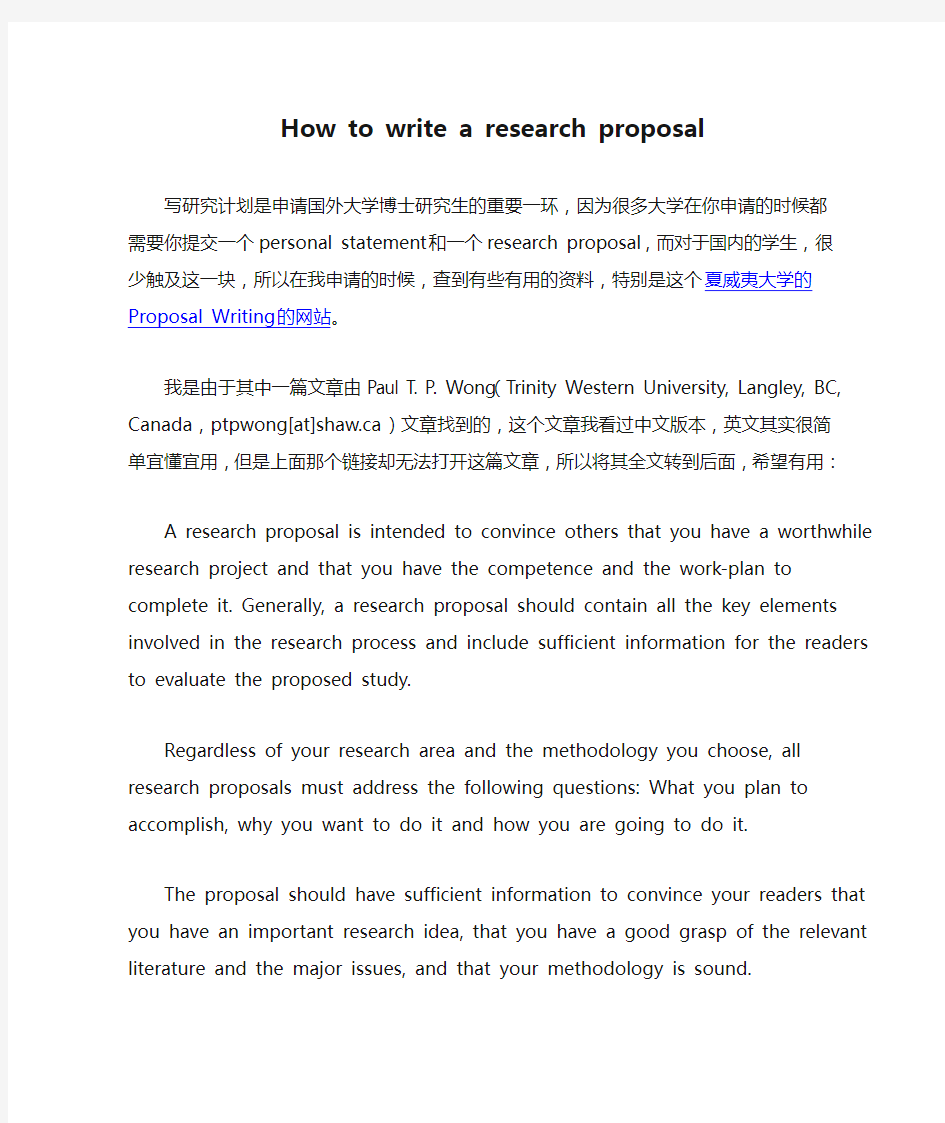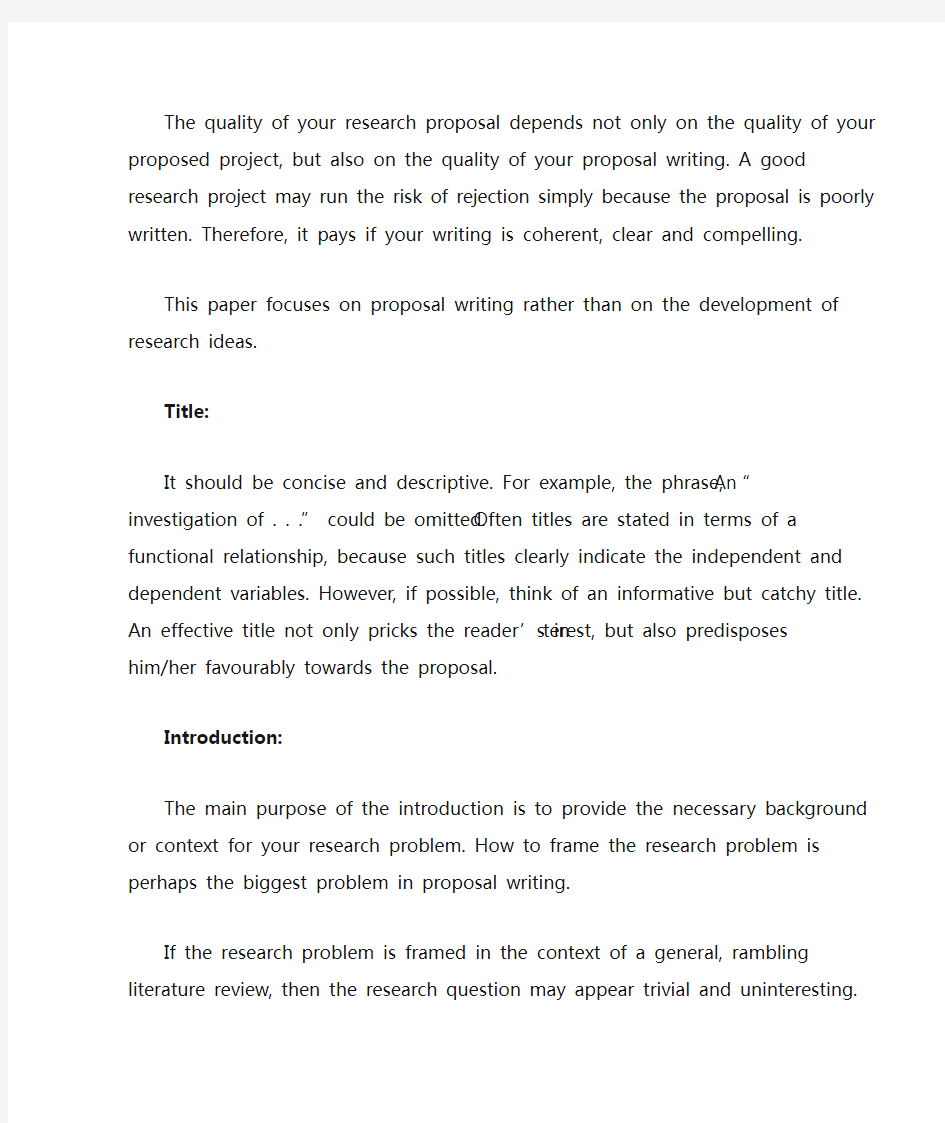How to write a research proposal


How to write a research proposal
写研究计划是申请国外大学博士研究生的重要一环,因为很多大学在你申请的时候都需要你提交一个personal statement和一个research proposal,而对于国内的学生,很少触及这一块,所以在我申请的时候,查到有些有用的资料,特别是这个夏威夷大学的Proposal Writing的网站。
我是由于其中一篇文章由Paul T. P. Wong(Trinity Western University, Langley, BC, Canada,ptpwong[at]shaw.ca)文章找到的,这个文章我看过中文版本,英文其实很简单宜懂宜用,但是上面那个链接却无法打开这篇文章,所以将其全文转到后面,希望有用:
A research proposal is intended to convince others that you have a worthwhile research project and that you have the competence and the work-plan to complete it. Generally, a research proposal should contain all the key elements involved in the research process and include sufficient information for the readers to evaluate the proposed study.
Regardless of your research area and the methodology you choose, all research proposals must address the following questions: What you plan to accomplish, why you want to do it and how you are going to do it.
The proposal should have sufficient information to convince your readers that you have an important research idea, that you have a good grasp of the relevant literature and the major issues, and that your methodology is sound.
The quality of your research proposal depends not only on the quality of your proposed project, but also on the quality of your proposal writing. A good research project may run the risk of rejection simply because the proposal is poorly written. Therefore, it pays if your writing is coherent, clear and compelling.
This paper focuses on proposal writing rather than on the development of research ideas.
Title:
It should be concise and descriptive. For example, the phrase, “An investigation
of . . .” could be omitted. Often titles are stated in terms of a functional relationship, because such titles clearly indicate the independent and dependent variables. However, if possible, think of an informative but catchy title. An effective title not only pricks the reader’s in terest, but also predisposes him/her favourably towards the proposal. Introduction:
The main purpose of the introduction is to provide the necessary background or
context for your research problem. How to frame the research problem is perhaps the biggest problem in proposal writing.
If the research problem is framed in the context of a general, rambling literature review, then the research question may appear trivial and uninteresting. However, if the same question is placed in the context of a very focused and current research area, its significance will become evident.
Unfortunately, there are no hard and fast rules on how to frame your research question just as there is no prescription on how to write an interesting and informative opening paragraph. A lot depends on your creativity, your ability to think clearly and the depth of your understanding of problem areas.
However, try to place your research question in the context of either a current “hot” area, or an older area that remains viable. Secondly, you need to provide a brief but appropriate historical backdrop. Thirdly, provide the contemporary context in which your proposed research question occupies the central stage. Finally, identify “key players” and refer to the most relevant and representative publications. In short, try to paint your research question in broad brushes and at the same time bring out its significance.
The introduction typically begins with a general statement of the problem area, with a focus on a specific research problem, to be followed by the rational or justification for the proposed study. The introduction generally covers the following elements:
1. State the research problem, which is often referred to as the purpose of the study.
2. Provide the context and set the stage for your research question in such a way as to show its necessity and importance.
3. Present the rationale of your proposed study and clearly indicate why it is worth doing.
4. Briefly describe the major issues and sub-problems to be addressed by your research.
5. Identify the key independent and dependent variables of your experiment. Alternatively, specify the phenomenon you want to study.
6. State your hypothesis or theory, if any.
7. Set the delimitation or boundaries of your proposed research in order to provide a clear focus.
8. Provide definitions of key concepts. (This is optional.)
Literature Review:
Sometimes the literature review is incorporated into the introduction section. However, most professors prefer a separate section, which allows a more thorough review of the literature.
The literature review serves several important functions:
1. Ensures that you are not “reinventing the wheel”.
2. Gives credits to those who have laid the groundwork for your research.
3. Demonstrates your knowledge of the research problem.
4. Demonstrates your understanding of the theoretical and research issues related to your research question.
5. Shows your ability to critically evaluate relevant literature information.
6. Indicates your ability to integrate and synthesize the existing literature.
7. Provides new theoretical insights or develops a new model as the conceptual framework for your research.
8. Convinces your reader that your proposed research will make a significant and substantial contribution to the literature (i.e., resolving an important theoretical issue or filling a major gap in the literature).
Most students’ literature reviews suffer f rom the following problems:
? Lacking organization and structure
? Lacking focus, unity and coherence
? Being repetitive and verbose
? Failing to cite influential papers
? Failing to keep up with recent developments
? Failing to critically evaluate cited p apers
? Citing irrelevant or trivial references
? Depending too much on secondary sources
Your scholarship and research competence will be questioned if any of the above applies to your proposal.
